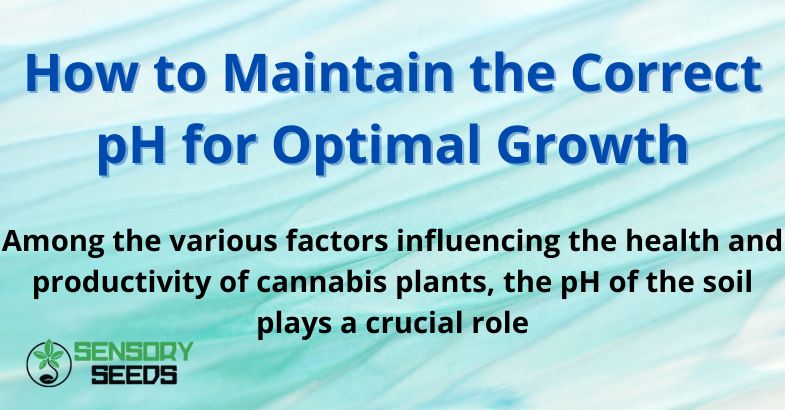Published on: 16/08/2024
Among the various factors influencing the health and productivity of cannabis plants, the pH of the soil plays a crucial role
Maintaining an optimal pH balance is crucial to ensure that plants can absorb the necessary nutrients and grow vigorously. In this article, we will explore the importance of pH for cannabis seeds, how to measure and adjust it, and how to maintain this balance for optimal growth.
What is pH and Why is It Important?
pH is a measure of the acidity or alkalinity of a solution, on a scale ranging from 0 to 14. A pH of 7 is considered neutral, values below 7 indicate acidity, and values above 7 indicate alkalinity.
For cannabis cultivation, the ideal pH of the soil or growing medium should be between 6.0 and 7.0 for soil and between 5.5 and 6.5 for hydroponic systems.
The importance of pH lies in its direct impact on nutrient availability for plants. Each essential nutrient has a specific pH range within which it can be effectively absorbed by the plant’s roots. When pH levels fall outside this range, some nutrients may become less available, leading to nutritional deficiencies that can compromise plant growth and reduce yields.
For example, a pH that is too low (too acidic) can limit the absorption of calcium, magnesium, and phosphorus, while a pH that is too high (too alkaline) can reduce the availability of iron, manganese, and boron. These deficiencies can manifest in visible symptoms such as leaf yellowing, stunted growth, and decreased flower production.
Read also: An overview of the close relationship between cannabis and music


How to Measure Soil pH levels
To maintain an optimal pH balance, it’s essential to measure it regularly. There are several tools and methods:
- Strips: pH test strips are an economical and simple method for measuring pH. The strips change colour when immersed in the solution, and the colour can be compared to a reference scale to determine the pH level.
- Digital measuring devices: These tools offer a more precise and immediate reading of pH. They require regular calibration with reference solutions to ensure measurement accuracy.
- Testing kits: These kits include chemical reagents that change colour based on the pH of the soil sample. Although they are less precise than digital measuring devices, they are still useful for obtaining an approximate estimate of soil pH.
- Probes: These devices are inserted directly into the soil to measure pH. They can provide a continuous reading of pH, making them ideal for long-term monitoring.
How to Adjust pH levels
Once the pH is measured, it may be necessary to adjust it to maintain the optimal balance. Various methods and products are available to either increase or decrease the pH:
- To Raise the pH (make it more alkaline):
- Agricultural lime: Dolomitic or calcitic lime can be added to the soil to raise the pH. Dolomitic lime also provides magnesium, which is beneficial for plant growth.
- Potassium carbonate: This compound can be used to raise the pH of nutrient solutions in hydroponics.
- o Lower the pH (make it more acidic):
- Sulphur: Adding sulphur to the soil can lower the pH over time, as soil bacteria convert sulphur into sulphuric acid.
- Organic acids: Citric acid or phosphoric acid can be used to lower the pH of nutrient solutions.
It is important to proceed with caution when adjusting the pH, making gradual changes and carefully monitoring the reactions of the plants. Sudden and drastic changes can cause stress to the plants and worsen the situation.
How to monitor and maintain the same pH level?
The pH of the growing medium can change over time due to several factors, including nutrient uptake, fertiliser addition and changes in environmental conditions. Therefore, it is essential to monitor pH regularly and make any necessary corrections.
A good pH monitoring programme should include:
- Regular measurements: check the pH of the soil or nutrient solution at least once a week, or more frequently if signs of nutritional imbalance are noted in the plants;
- Recording data: keep a record of pH measurements and corrections made. This can help identify trends and make informed pH management decisions;
- Tool maintenance: Calibrate digital pH meters regularly and replace worn probes to ensure accurate measurements.


Signs of pH Imbalance and How to Correct Them
Recognising the signs of a pH imbalance is crucial for early intervention and preventing plant damage. Some of the common symptoms of an unbalanced pH include:
- Yellowing of leaves: may indicate a deficiency of nutrients such as nitrogen, iron or magnesium, often caused by an incorrect pH;
- Stunted growth: a pH outside the optimal range can reduce the availability of essential nutrients, slowing plant growth;
- Stains on leaves: brown spots or necrosis may be symptoms of calcium or magnesium deficiency, linked to an unbalanced pH.
To correct a pH imbalance, it is important to first identify the cause. If the pH is too high or too low, specific soil conditioners can be used to adjust it, as described above.
In addition, making sure to irrigate with pH-corrected water and using balanced fertilisers can help maintain a stable pH.
Read also: The Origin of Cannabis
Conclusions
Maintaining an optimal pH balance is essential for the healthy and productive growth of cannabis plants. Proper pH ensures that plants can absorb the necessary nutrients, preventing nutritional deficiencies and promoting vigorous growth.
In summary, understanding the importance of pH and adopting proper management practices can make the difference between a mediocre and an exceptional harvest. With constant attention and a proactive approach, it is possible to create the ideal conditions for growing healthy, productive cannabis plants while maximising the quality and quantity of the harvest.
Not sure where to buy cannabis seeds to start growing your own seedlings? Check out SensorySeeds’ website.









